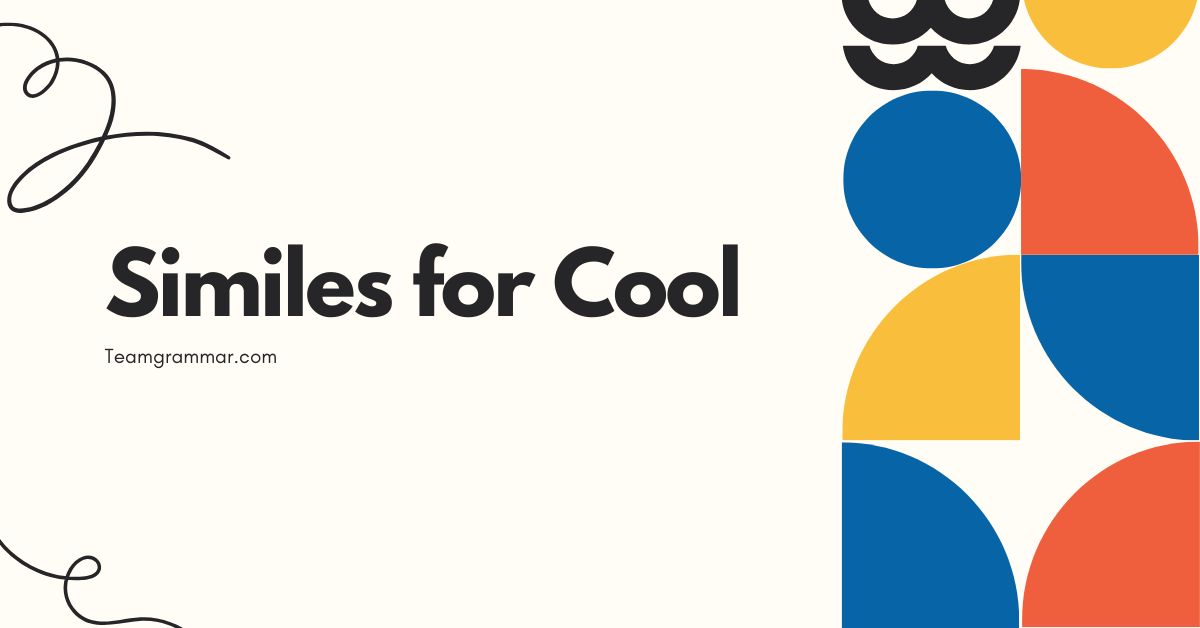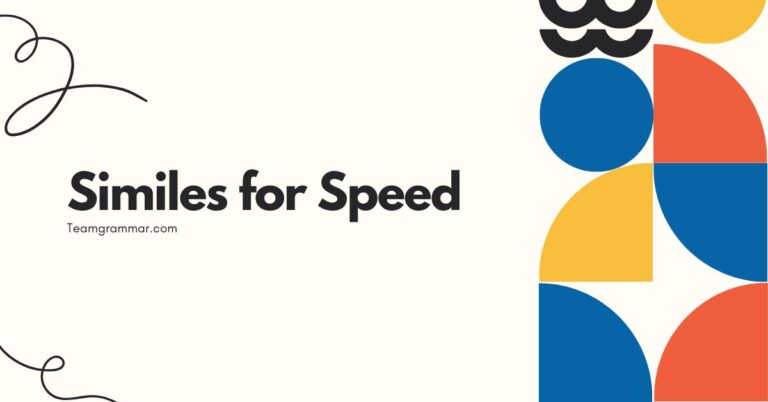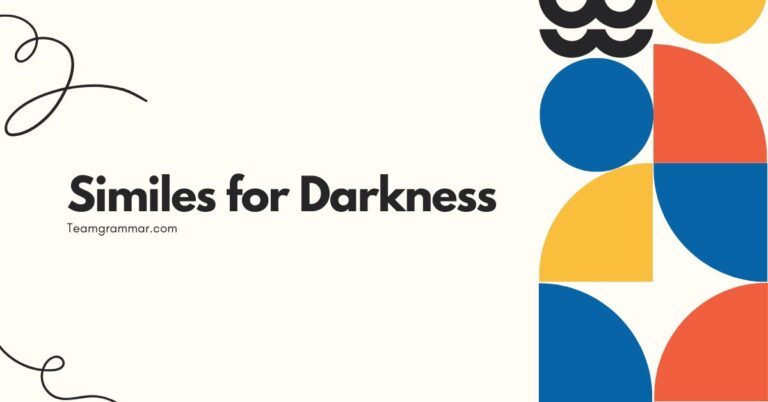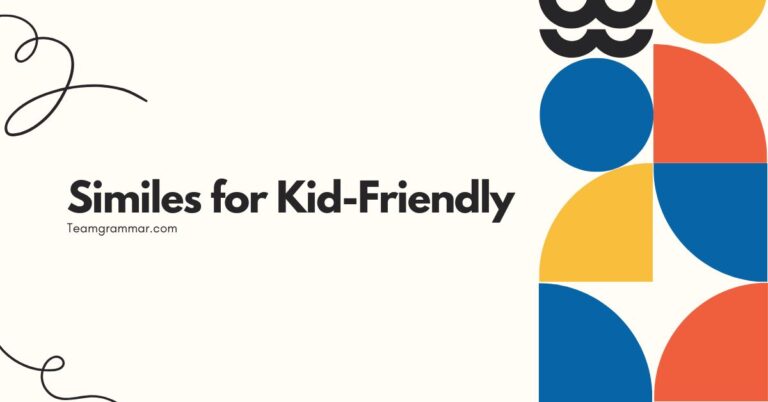41 Similes for Cool: Mastering Figurative Language
Understanding similes is essential for enhancing your writing and communication skills. Similes, a type of figurative language, allow us to make vivid comparisons, adding depth and color to our descriptions.
Mastering similes, especially when describing something as “cool,” enables you to move beyond simple adjectives and express nuances that capture the imagination. This article provides a comprehensive guide to using similes for “cool,” covering definitions, structures, examples, usage rules, common mistakes, and practice exercises.
Whether you are a student, writer, or language enthusiast, this guide will help you effectively incorporate similes into your vocabulary and writing, making your language more engaging and impactful.
Table of Contents
- Introduction
- Definition of Similes
- Structural Breakdown of Similes
- Types of Similes
- Examples of Similes for “Cool”
- Usage Rules for Similes
- Common Mistakes in Simile Usage
- Practice Exercises
- Advanced Topics in Similes
- FAQ
- Conclusion
Definition of Similes
A simile is a figure of speech that compares two different things using the words “like” or “as.” The purpose of a simile is to create a vivid and imaginative comparison that helps the reader or listener better understand or visualize the subject being described. Similes are powerful tools for adding color, depth, and interest to writing and speech.
They allow you to draw connections between seemingly unrelated things, highlighting specific qualities or characteristics.
In essence, a simile functions as a bridge between two distinct concepts, enriching the description and making it more relatable or impactful. They are commonly used in literature, poetry, and everyday conversation to enhance understanding and evoke emotions.
The key to a good simile is that the comparison should be meaningful and create a clear image or idea in the mind of the audience. It’s not merely about stating similarities, but about elevating the description through imaginative association.
Classification of Similes
Similes are classified as a type of figurative language, specifically a figure of comparison. They belong to a broader category that includes metaphors, analogies, and personifications.
What distinguishes similes is their explicit use of “like” or “as” to draw the comparison. This explicit comparison differentiates them from metaphors, which imply the comparison without using these words.
Understanding this classification helps in recognizing and using similes effectively.
Figurative language, in general, is used to create effects that go beyond the literal meaning of the words. Similes, with their direct comparative structure, offer a straightforward yet powerful way to achieve this.
They enable writers and speakers to communicate complex ideas or emotions in a concise and engaging manner. By understanding where similes fit within the landscape of figurative language, one can better appreciate their unique role and potential.
Function of Similes
The primary function of a simile is to enhance understanding and create vivid imagery by comparing two dissimilar things. Similes help to clarify complex ideas, evoke emotions, and make descriptions more memorable.
They transform simple statements into engaging and imaginative expressions. By drawing a parallel between the subject and something familiar, similes make the subject more accessible and relatable to the audience.
Furthermore, similes add stylistic flair to writing and speech, making them more interesting and persuasive. They can be used to emphasize specific qualities or characteristics of the subject, highlighting aspects that might otherwise be overlooked.
In literature, similes often contribute to the overall tone and theme of the work, adding layers of meaning and interpretation. The function of similes extends beyond mere comparison; it is about creating a richer and more engaging experience for the reader or listener.
Contexts for Using Similes
Similes are versatile and can be used in a wide range of contexts, from formal writing to casual conversation. In literature, they are commonly found in poetry, novels, and short stories to enrich descriptions and deepen emotional impact.
In academic writing, similes can be used to explain complex concepts by relating them to more familiar ideas. In everyday conversation, similes add color and humor to our speech, making it more engaging and expressive.
Moreover, similes are frequently used in advertising and marketing to make products more appealing or memorable. They can also be found in speeches and presentations to persuade and inspire audiences.
The key is to choose similes that are appropriate for the context and audience, ensuring that the comparison is relevant and effective. Understanding the different contexts in which similes can be used allows you to tailor your language to suit the specific situation, enhancing your communication skills.
Structural Breakdown of Similes
The basic structure of a simile consists of two parts: the subject being described and the object to which it is being compared, connected by the words “like” or “as.” Understanding this structure is crucial for creating effective and meaningful similes. The subject and object should be different enough to make the comparison interesting, but similar enough to create a clear connection.
The formula for a simile can be expressed as:Subject + “like” or “as” + Object. This simple structure allows for a wide range of creative possibilities, as long as the comparison is logical and enhances the description.
The effectiveness of a simile depends on the clarity and relevance of the comparison, as well as the vividness of the imagery it creates.
The Subject
The subject is the thing or idea being described in the simile. It is the focus of the comparison and the element that the simile aims to illuminate or enhance.
The subject can be a person, place, object, concept, or emotion. The key is to choose a subject that can benefit from a comparison, where the simile can add depth and understanding.
When selecting a subject, consider what aspects you want to highlight. Is it the subject’s appearance, behavior, or qualities?
The choice of subject will influence the rest of the simile, particularly the object to which it is compared. A well-chosen subject is essential for creating a compelling and effective simile.
Comparison Words: “Like” and “As”
The words “like” and “as” are the essential connectors in a simile, explicitly indicating that a comparison is being made. “Like” is used to suggest a similarity or resemblance, while “as” can be used in various constructions, such as “as…as” to indicate equality or degree.
The choice between “like” and “as” often depends on the specific nuance you want to convey.
While “like” and “as” are the most common comparison words, it’s important to use them correctly to avoid ambiguity or confusion. In formal writing, “as” is often preferred for more precise comparisons, while “like” is more commonly used in informal contexts.
Understanding the subtle differences between these words can help you craft more effective and nuanced similes.
The Object
The object is the thing to which the subject is being compared in the simile. It provides a point of reference that helps the audience better understand or visualize the subject.
The object should be something familiar or easily understood, so that the comparison is clear and effective. The key is to choose an object that shares a relevant characteristic with the subject.
The object can be anything, from a tangible item to an abstract concept. The more imaginative and unexpected the object, the more striking the simile can be.
However, it’s important to ensure that the comparison is still logical and meaningful. A well-chosen object can transform a simple description into a vivid and memorable image.
Types of Similes
While all similes share the same basic structure, they can be categorized based on the type of comparison they make. Understanding these categories can help you create more specific and effective similes.
Some common types of similes include descriptive similes, emotional similes, and functional similes.
Descriptive similes focus on physical attributes or appearances, emotional similes convey feelings or moods, and functional similes highlight the way something works or behaves. By recognizing these different types, you can tailor your similes to achieve specific effects in your writing or speech.
Descriptive Similes
Descriptive similes focus on the physical attributes or appearances of the subject. They often use sensory details to create a vivid image in the reader’s mind.
These similes are particularly useful for painting a picture of the subject, helping the audience visualize its appearance.
For example, “The cool breeze was like a gentle caress” uses the descriptive element of touch to convey the feeling of the breeze. Descriptive similes are common in literature and poetry, where creating a strong visual impression is essential.
Emotional Similes
Emotional similes convey feelings or moods associated with the subject. They help the audience understand the emotional impact of the subject by comparing it to something that evokes a similar emotion.
These similes are powerful tools for creating empathy and connection with the audience.
For example, “His cool demeanor was like a shield against the world” uses the emotional impact of a shield to convey the sense of protection and detachment. Emotional similes are often used in personal narratives and persuasive writing to evoke specific feelings.
Functional Similes
Functional similes highlight the way something works or behaves. They explain the subject’s function by comparing it to something that operates in a similar manner.
These similes are useful for clarifying complex processes or behaviors.
For example, “The cool gadget worked like a charm” uses the functional aspect of a charm to convey the effectiveness of the gadget. Functional similes are often used in technical writing and explanations to make complex concepts more accessible.
Examples of Similes for “Cool”
Using similes to describe something as “cool” can add depth and creativity to your language. The following examples are categorized to help you understand the different ways you can use similes to convey the idea of “coolness.” These examples cover various aspects, from temperature and appearance to attitude and behavior.
Below are several tables filled with examples of similes for ‘cool.’ Each table focuses on a different aspect of ‘coolness’, providing a variety of options for your writing and speech. Each table contains 25-30 examples.
Similes Describing Temperature
The following table presents similes that describe ‘cool’ in terms of temperature, often relating to a refreshing or pleasant coldness.
| Simile | Explanation |
|---|---|
| As cool as a cucumber | Implies a calm and composed demeanor. |
| Like a dip in a cool pool on a hot day | Suggests a refreshing and pleasant experience. |
| As cool as the underside of a pillow | Evokes a sense of comfort and coolness. |
| Like a glass of iced tea on a summer afternoon | Conveys a refreshing and revitalizing feeling. |
| As cool as a mountain breeze | Implies a natural and refreshing coolness. |
| Like the shade of a tall tree on a sunny day | Suggests relief and coolness from the heat. |
| As cool as a chilled martini | Evokes sophistication and a refreshing chill. |
| Like stepping into an air-conditioned room | Conveys immediate relief from heat. |
| As cool as a winter’s night | Implies a crisp and invigorating coolness. |
| Like the first bite of ice cream on a hot day | Suggests a delightful and cooling sensation. |
| As cool as the ocean’s depths | Implies a profound and constant coolness. |
| Like a cold compress on a fevered brow | Conveys soothing relief and coolness. |
| As cool as a penguin in Antarctica | Implies an extreme and inherent coolness. |
| Like a sip of peppermint tea | Suggests a refreshing and slightly cooling sensation. |
| As cool as a cucumber sandwich | Evokes a light and refreshing taste. |
| Like a snowy morning | Conveys a pristine and cool atmosphere. |
| As cool as a granite countertop | Implies a smooth, hard, and cool surface. |
| Like a frosty window pane | Suggests a delicate and icy coolness. |
| As cool as a cave’s interior | Implies a dark, damp, and consistently cool environment. |
| Like a chilled watermelon slice | Conveys a juicy, refreshing, and cool taste. |
| As cool as a polar bear | Suggests a natural resistance to cold. |
| Like a breath of winter air | Implies a sharp, invigorating coolness. |
| As cool as a dew-kissed leaf | Conveys a fresh and gentle coolness. |
| Like the touch of marble in summer | Suggests a smooth, refreshing coolness. |
| As cool as an iceberg | Implies a massive, imposing coolness. |
| Like a frozen waterfall | Conveys a powerful, icy coolness. |
Similes Describing Appearance
This table provides similes that describe ‘cool’ in terms of appearance, often relating to a stylish or impressive look.
| Simile | Explanation |
|---|---|
| As cool as a movie star in sunglasses | Implies a stylish and confident appearance. |
| Like a perfectly tailored suit | Suggests sophistication and attention to detail. |
| As cool as a vintage sports car | Evokes a sense of timeless style and class. |
| Like a sleek, modern skyscraper | Conveys a sense of innovation and sophistication. |
| As cool as a street art mural | Implies creativity and urban style. |
| Like a minimalist design | Suggests simplicity and understated elegance. |
| As cool as a custom motorcycle | Evokes a sense of rebellion and individuality. |
| Like a high-fashion runway model | Conveys a sense of trendsetting style. |
| As cool as a well-groomed rock star | Implies a combination of style and attitude. |
| Like a perfectly crafted piece of jewelry | Suggests attention to detail and elegance. |
| As cool as a limited-edition sneaker | Evokes a sense of exclusivity and style. |
| Like a classic black and white photograph | Conveys a timeless and sophisticated look. |
| As cool as a designer handbag | Implies a sense of luxury and style. |
| Like a perfectly styled hairstyle | Suggests attention to detail and fashion. |
| As cool as a bespoke suit | Evokes a sense of custom-made perfection. |
| Like a pristine white canvas | Conveys simplicity and potential. |
| As cool as a chrome finish | Implies a sleek and modern appearance. |
| Like a perfectly arranged gallery exhibit | Suggests sophistication and artistic flair. |
| As cool as a high-tech gadget | Evokes a sense of innovation and modernity. |
| Like a well-designed logo | Conveys professionalism and style. |
| As cool as a shaded tattoo | Suggests artistic detail and edginess. |
| Like a polished gemstone | Implies beauty and refinement. |
| As cool as a starlit sky | Conveys a vast and beautiful appearance. |
| Like a perfectly lit stage | Suggests drama and visual appeal. |
| As cool as a mirrored surface | Implies sleekness and modernity. |
| Like an expertly crafted watch | Conveys precision and style. |
Similes Describing Attitude and Behavior
The following table presents similes that describe ‘cool’ in terms of attitude and behavior, often relating to composure, confidence, and collectedness.
| Simile | Explanation |
|---|---|
| As cool as a cat | Implies a relaxed and self-assured attitude. |
| Like a seasoned professional under pressure | Suggests composure and competence. |
| As cool as a spy on a mission | Evokes a sense of stealth and confidence. |
| Like a Zen master in meditation | Conveys calmness and inner peace. |
| As cool as a poker player with a winning hand | Implies confidence and control. |
| Like a surgeon during a critical operation | Suggests focus and precision. |
| As cool as a jazz musician improvising a solo | Evokes creativity and spontaneity. |
| Like a diplomat negotiating a peace treaty | Conveys tact and diplomacy. |
| As cool as a pilot landing a plane in a storm | Implies skill and composure under pressure. |
| Like a chess grandmaster planning a move | Suggests strategic thinking and foresight. |
| As cool as a CEO addressing shareholders | Evokes confidence and leadership. |
| Like a firefighter entering a burning building | Conveys bravery and determination. |
| As cool as a detective solving a mystery | Implies intelligence and problem-solving skills. |
| Like a dancer performing a flawless routine | Suggests grace and precision. |
| As cool as a mountain climber reaching the summit | Evokes determination and achievement. |
| Like a writer crafting a perfect sentence | Conveys attention to detail and creativity. |
| As cool as a teacher guiding students | Implies patience and wisdom. |
| Like a gardener nurturing a delicate plant | Suggests care and attention. |
| As cool as a librarian organizing books | Evokes order and knowledge. |
| Like an artist creating a masterpiece | Conveys passion and skill. |
| As cool as a monk in prayer | Suggests serenity and focus. |
| Like a scientist making a discovery | Implies curiosity and intellect. |
| As cool as a judge delivering a verdict | Conveys authority and impartiality. |
| Like a conductor leading an orchestra | Suggests control and harmony. |
| As cool as an astronaut in space | Implies bravery and exploration. |
| Like a tightrope walker maintaining balance | Conveys skill and focus. |
Similes Describing Abstract Concepts of Coolness
The following table includes similes to describe an abstract concept of cool, such as a moment, idea or atmosphere.
| Simile | Explanation |
|---|---|
| As cool as a sudden breeze in a stifling room. | A refreshing, unexpected coolness. |
| Like a perfectly placed note in a jazz solo. | A moment of flawless execution and style. |
| As cool as the first snowfall of the year. | Pristine, beautiful, and refreshing. |
| Like a secret whispered in the dark. | Intriguing, mysterious, and exciting. |
| As cool as a hidden speakeasy in the 1920s. | Exclusive, underground, and exciting. |
| Like the moment you understand a complex idea. | Satisfying, enlightening, and intellectually cool. |
| As cool as a well-executed surprise party. | Joyful, unexpected, and memorable. |
| Like discovering a new genre of music you love. | Exciting, fresh, and personally enriching. |
| As cool as the feeling of clean sheets on a warm night. | Comforting, simple, and pure. |
| Like a perfectly timed joke that lands with everyone. | Humorous, clever, and socially rewarding. |
| As cool as a vintage photograph of a forgotten era. | Nostalgic, intriguing, and historically significant. |
| Like the sound of rain against a windowpane at night. | Relaxing, soothing, and atmospheric. |
| As cool as finding a rare book in a used bookstore. | Exciting, unique, and rewarding. |
| Like a spontaneous road trip with no destination in mind. | Adventurous, free, and exhilarating. |
| As cool as a perfectly brewed cup of coffee on a cold morning. | Comforting, invigorating, and satisfying. |
| Like a meaningful conversation with a close friend. | Intimate, honest, and emotionally fulfilling. |
| As cool as the first day of summer vacation. | Carefree, joyful, and full of possibilities. |
| Like stumbling upon a breathtaking view after a long hike. | Rewarding, beautiful, and awe-inspiring. |
| As cool as watching a shooting star on a clear night. | Magical, rare, and unforgettable. |
| Like the moment you realize you’re exactly where you’re meant to be. | Peaceful, content, and deeply satisfying. |
| As cool as a quiet library on a rainy day. | Peaceful, serene, and intellectually stimulating. |
| Like the feeling of sand between your toes at the beach. | Relaxing, grounding, and naturally cool. |
| As cool as a well-deserved standing ovation. | Rewarding, validating, and publicly appreciated. |
| Like the moment when the sun breaks through storm clouds. | Hopeful, bright, and uplifting. |
| As cool as a perfectly aligned row of dominoes. | Satisfying, precise, and visually appealing. |
| Like the taste of fresh, home-baked bread. | Comforting, warm, and nostalgic. |
Usage Rules for Similes
Using similes effectively requires understanding and following certain rules. These rules ensure that your similes are clear, meaningful, and appropriate for the context.
The key is to create comparisons that enhance understanding and add value to your writing or speech.
Some important rules include ensuring that the comparison is logical, avoiding clichés, and using similes sparingly. By following these guidelines, you can create similes that are both creative and effective.
Ensuring Logical Comparison
The most important rule for using similes is to ensure that the comparison is logical and makes sense. The subject and object should share a relevant characteristic that justifies the comparison.
If the comparison is too far-fetched or nonsensical, the simile will be ineffective and may confuse the audience.
For example, comparing “coolness” to something that is universally understood as refreshing or calming is logical. If you are describing a person’s cool demeanor, comparing it to a calm sea makes logical sense, as both evoke a sense of tranquility and control.
Avoiding Clichés
Clichés are overused and unoriginal expressions that have lost their impact. Using clichés in your similes can make your writing seem lazy and uninspired.
It’s important to avoid common similes and instead create fresh and original comparisons.
Instead of saying “as cool as a cucumber,” which is a common cliché, try something more original, such as “as cool as a mountain stream.” The key is to think creatively and find comparisons that are both meaningful and unique.
Using Similes Sparingly
While similes can add depth and interest to your writing, it’s important to use them sparingly. Overusing similes can make your writing seem cluttered and distracting.
Use similes only when they serve a specific purpose and enhance the description.
A well-placed simile can have a powerful impact, but too many similes can dilute the overall effect. Be selective and use similes strategically to maximize their impact.
Common Mistakes in Simile Usage
Even experienced writers can make mistakes when using similes. Recognizing these common errors can help you avoid them and improve the effectiveness of your writing.
Some common mistakes include illogical comparisons, mixed metaphors, and overuse of similes.
By understanding these pitfalls, you can craft similes that are clear, meaningful, and impactful.
Illogical Comparisons
One of the most common mistakes is making comparisons that don’t make logical sense. The subject and object should share a relevant characteristic that justifies the comparison.
If the comparison is too far-fetched or nonsensical, the simile will be ineffective.
Incorrect:The cool breeze was like a roaring lion. (A breeze cannot roar.)Correct:The cool breeze was like a gentle whisper.
(A breeze can be gentle and quiet.)
Mixed Metaphors
While technically a simile is not a metaphor, mixing a simile with a metaphor, or mixing various similes can create a confusing image for the reader.
Incorrect:The cool idea was a breath of fresh air, sailing smoothly. (Mixing a breath of air with sailing creates a confusing image.)Correct:The cool idea was like a breath of fresh air.
(Clear and consistent comparison.)
Overuse of Similes
Using too many similes in a short passage can make your writing seem cluttered and distracting. Similes should be used sparingly, only when they serve a specific purpose and enhance the description.
Incorrect:The day was like a furnace, the sun like a spotlight, and the air like soup. (Too many similes in one sentence.)Correct:The day was like a furnace.
(One well-placed simile is more effective.)
Practice Exercises
To master the use of similes for “cool,” practice is essential. The following exercises will help you identify and create effective similes.
Each exercise focuses on a different aspect of simile usage, from identifying similes to creating original comparisons.
Complete the exercises to reinforce your understanding and improve your skills in using similes.
Exercise 1: Identifying Similes
Identify the similes in the following sentences:
| Question | Answer |
|---|---|
| 1. The cool water felt like silk against my skin. | The cool water felt like silk against my skin. |
| 2. He was as cool as a cucumber under pressure. | He was as cool as a cucumber under pressure. |
| 3. The idea was a breath of fresh air. | (No simile) |
| 4. She moved as gracefully as a dancer. | She moved as gracefully as a dancer. |
| 5. The gadget worked like a charm. | The gadget worked like a charm. |
| 6. The room was as cool as a cave. | The room was as cool as a cave. |
| 7. The night was dark and mysterious. | (No simile) |
| 8. The solution was as clear as day. | The solution was as clear as day. |
| 9. His voice was like velvet. | His voice was like velvet. |
| 10. The task was as easy as pie. | The task was as easy as pie. |
Exercise 2: Completing Similes
Complete the following similes with appropriate endings:
| Question | Answer |
|---|---|
| 1. As cool as ________. | As cool as a mountain breeze. |
| 2. Like a ________ in the desert. | Like a cool oasis in the desert. |
| 3. As cool as ________. | As cool as a winter’s night. |
| 4. Like a ________ on a hot day. | Like a cold drink on a hot day. |
| 5. As cool as ________. | As cool as an iceberg. |
| 6. Like a ________ in summer. | Like a dip in the ocean in summer. |
| 7. As cool as ________. | As cool as a cucumber. |
| 8. Like a ________ after a workout. | Like a cold shower after a workout. |
| 9. As cool as ________. | As cool as a shaded porch. |
| 10. Like a ________ on a sunny day. | Like a cool breeze on a sunny day. |
Exercise 3: Creating Original Similes
Create original similes to describe the following:
| Question | Answer |
|---|---|
| 1. A cool attitude | Like a calm sea, unperturbed by storms. |
| 2. A cool gadget | As innovative as a futuristic invention. |
| 3. A cool drink | Like a refreshing waterfall on a summer day. |
| 4. A cool room | As inviting as a shaded forest. |
| 5. A cool idea | Like a breath of fresh air in a stuffy room. |
| 6. A cool style | As timeless as a classic black dress. |
| 7. A cool song | Like a gentle breeze on a hot day, instantly refreshing. |
| 8. A cool evening | As peaceful as a quiet, starlit night. |
| 9. A cool car | Like a sleek predator gliding through the streets. |
| 10. A cool personality | As grounding as an ancient tree, solid and dependable. |
Advanced Topics in Similes
For advanced learners, exploring more complex aspects of similes can further enhance your writing skills. These topics include using extended similes, combining similes with other figures of speech, and adapting similes for different audiences.
Mastering these advanced techniques will allow you to create similes that are not only creative but also sophisticated and impactful.
Extended Similes
An extended simile is a simile that is developed over several lines or sentences, providing a more detailed and elaborate comparison. This technique allows you to explore the connection between the subject and object in greater depth, creating a more vivid and memorable image.
For example, instead of saying “The cool breeze was like a gentle caress,” you could say: “The cool breeze was like a gentle caress, softly touching my skin, easing the heat of the day, and bringing a sense of calm and relaxation.”
Combining Similes with Other Figures of Speech
Similes can be combined with other figures of speech, such as metaphors, personification, and hyperbole, to create more complex and layered descriptions. This technique can add depth and richness to your writing, making it more engaging and impactful.
For example, you could combine a simile with personification: “The cool idea was like a breath of fresh air, whispering possibilities into my ear.”
Adapting Similes for Different Audiences
The effectiveness of a simile depends on the audience’s understanding and appreciation of the comparison. It’s important to adapt your similes to suit the specific audience, considering their knowledge, background, and cultural context.
For example, a simile that works well for a technical audience may not be effective for a general audience. Tailor your similes to ensure that they are relevant and meaningful to the intended audience.
FAQ
Here are some frequently asked questions about similes:
- What is the difference between a simile and a metaphor?
A simile is a comparison using “like” or “as,” while a metaphor is an implied comparison without using these words. Similes are more explicit, while metaphors are more suggestive.
- How can I avoid using clichés in my similes?
To avoid clichés, think creatively and find original comparisons that are both meaningful and unique. Try to move beyond common expressions and explore fresh perspectives.
- How many similes should I use in a piece of writing?
Use similes sparingly, only when they serve a specific purpose and enhance the description. Overusing similes can make your writing seem cluttered and distracting.
- Can I use similes in formal writing?
Yes, similes can be used in formal writing, but they should be used judiciously and appropriately for the context. Ensure that the comparisons are clear, logical, and enhance understanding.
- What makes a simile effective?
An effective simile is clear, logical, and creates a vivid image in the reader’s mind. It should enhance understanding and add value to the writing or speech.
Conclusion
Mastering the use of similes for “cool” involves understanding their definition, structure, types, and usage rules. By avoiding common mistakes and practicing regularly, you can enhance your writing and communication skills.
Similes are powerful tools for adding depth, color, and creativity to your language, making it more engaging and impactful. Whether you are describing temperature, appearance, attitude, or abstract concepts, similes can help you convey the essence of “coolness” in a vivid and memorable way.
Embrace the art of comparison and elevate your language with well-crafted similes.







